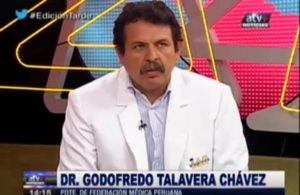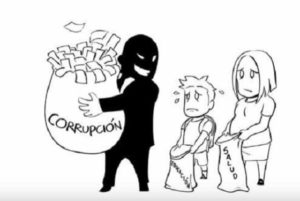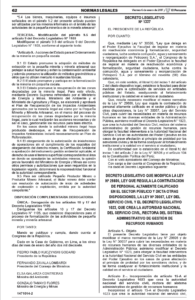Categoría: Políticas Públicas
Designan nuevo jefe del SIS en reemplazo de Edmundo Beteta
Mediante una resolución publicada en el diario oficial El Peruano este miércoles, se dio a conocer que Edmundo Beteta ya no seguirá como titular del Seguro Integral de Salud (SIS).
Según el texto, su reemplazante será Moisés Ernesto Rosas Febres, quien es un médico cirujano de profesión.
“(Se resuelve) dar por concluida la designación del economista Edmundo Pablo Beteta Obreros, en el cargo de Jefe del Seguro Integral de Salud, dándosele las gracias por los servicios prestados”, se lee en la resolución.
Como se recuerda, en octubre del 2016, la ministra de Salud, Patricia García, designó a Beteta tras el escándalo que provocó la destitución de Julio Acosta.
En esa misma fecha se anunció la reestructuración del SIS por el presunto caso de corrupción que se reveló con los audios de Carlos Moreno, exconsejero presidencial.
En: larepublica
Moisés Rosas Febres fue designado como nuevo jefe del Seguro Integral de Salud
De la misma el Ministerio de Salud dio por concluida la designación de Edmundo Beteta.
El Ministerio de Salud (Minsa) designó a Moisés Ernesto Rosas Febres nuevo jefe del Seguro Integral de Salud (SIS), según norma publicada hoy en el Diario Oficial El Peruano.
Asimismo, dieron dar por concluida la designación del economista Edmundo Pablo Beteta Obreros en el cargo de jefe del SIS, dándosele las gracias por los servicios prestados.
Ambas resoluciones supremas están refrendadas por el presidente Pedro Pablo Kuczynski y la ministra de Salud, Patricia García.
En: gestion
Moisés Rosas Febres es el nuevo jefe del Seguro Integral de Salud
Moisés Ernesto Rosas Febres es el nuevo jefe del Seguro Integral de Salud (SIS), según norma publicada hoy en el Diario Oficial El Peruano. Asimismo, se resuelve dar por concluida la designación del economista Edmundo Pablo Beteta Obreros.
A Edmundo Pablo Beteta Obreros se le dio las gracias por sus servicios prestados a la nación mediante un documento oficial refrendadas por el presidente Pedro Pablo Kuczynski y la ministra de Salud, Patricia García.
El pasado 9 de octubre del 2016, el Seguro Integral de Salud (SIS) fue declarado en reorganización por un plazo de 120 días a partir de ese día, mediante un decreto supremo. El propósito de la medida fue garantizar la idoneidad en la gestión de los recursos públicos.
Ahora, el nuevo jefe del SIS, Moisés Ernesto Rosas Febres, tendrá que ver este sistema que según el congresista de Fuerza Popular, Segundo Tapia, tiene muchas falencias técnicas, desorden, abandono y corrupción.
En: expreso
Resolución de la vergüenza: Dan por concluida designación de Jefe del Seguro Integral de Salud: RESOLUCIÓN SUPREMA Nº 007-2017-SA
La corrupción gana la batalla en Salud, por Jaime de Althaus
Edmundo Beteta ha caído porque empezaba a ordenar el SIS, racionalizar tarifas y eliminar corruptelas.

Ya podemos ir entendiendo las razones de la protesta de la Federación Médica y de los congresistas galenos. Se acababa el negocio. (Foto: El Comercio).
Jaime de Althaus – 02.06.2017 / 03:00 pm
La semana pasada la ministra de Salud le pidió su renuncia a Edmundo Beteta, jefe del SIS, cediendo a la presión del gremio médico y de sus representantes en el Congreso, que ya habían pedido la cabeza de Beteta y amenazaban con censurar a la propia ministra. Es una lástima. Beteta ha caído porque empezaba a ordenar el SIS, racionalizar tarifas y eliminar corruptelas. Y eso afectaba el statu quo ineficiente y plagado de intereses dedicados al desvío de recursos de los establecimientos de Salud.
El pecado de Beteta fue empezar a aplicar las recomendaciones del Informe de la Comisión Interventora del SIS que se creó luego del escándalo Moreno. Ese informe y luego el propio Beteta descubrieron la cantidad de milagros que el SIS había financiado: el parto de 194 hombres y de 143 ancianas y los de 34.812 mujeres que dieron a luz dos veces en menos de dos o tres meses. También la muerte, resurrección y nueva muerte de muchos que cobraron sepelio más de una vez, y 200 operaciones de catarata a un solo paciente, por ejemplo.
Beteta empezó a hacer auditorías a las prestaciones (no había control) y a poner tarifas que pagaran solo los gastos variables de las prestaciones, no los gastos fijos ni menos bonos remunerativos, que corresponden al presupuesto ordinario. Pero cometió sacrilegio cuando aplicó la recomendación del informe de cortar el incremento explosivo de los desvíos irregulares hacia clínicas privadas: el pago por atenciones en emergencias privadas había pasado de 1,7 millones de soles el 2014 a ¡114 millones! el 2016. Médicos de los propios hospitales aprovecharon para derivar pacientes que habían llegado a emergencias públicas, a sus clínicas privadas o a las de médicos amigos. O había muchos casos que no eran de emergencia u otros que se quedaban muchos días (28 casos de pacientes con estancias que se encuentran entre los ¡100 y 381 días!).
Beteta cortó todo eso: las emergencias en establecimientos privados bajaron abruptamente de 630 casos por un valor de 5,5 millones de soles en setiembre del 2016 a solo 5 casos por un valor de 10 mil soles en marzo del 2017.
Ya podemos ir entendiendo las razones de la protesta de la Federación Médica y de los congresistas galenos. Se acababa el negocio. Beteta estaba firmando convenios con hospitales y regiones con las nuevas reglas de juego. Se lo han tumbado cuando todavía faltaba firmar con la mayor parte de establecimientos y regiones. Adiós, reforma.
Es francamente desalentador. Es la consecuencia de un gobierno extremadamente débil que no ha sido capaz de buscar un acuerdo político con Fuerza Popular –que tampoco ha dado la menor señal de quererlo– para blindar procesos de reforma como este (el de la policía es otro) que afectan intereses poderosos y enquistados en el propio Congreso de la República. Me pregunto si todavía estamos a tiempo para rescatar un acuerdo como ese. De lo contrario, habremos perdido otros cinco años.
Resolución en la página web del Diario Oficial “El Peruano” (Documento .pdf): 1524324-1
Resolución en la página web del Diario Oficial “El Peruano”: http://busquedas.elperuano.com.pe/normaslegales/dan-por-concluida-designacion-de-jefe-del-seguro-integral-de-resolucion-suprema-n-007-2017-sa-1524324-1/
Dan por concluida designación de Jefe del Seguro Integral de Salud
RESOLUCIÓN SUPREMA Nº 007-2017-SA
Lima, 23 de mayo del 2017
CONSIDERANDO:
Que, mediante Resolución Suprema Nº 023-2016- SA, se designó al economista Edmundo Pablo Beteta Obreros, en el cargo de Jefe del Seguro Integral de Salud;
Que, se ha visto por conveniente dar por concluida la designación del citado funcionario;
De conformidad con lo dispuesto en la Ley Nº 27594, Ley que regula la participación del Poder Ejecutivo en el nombramiento y designación de funcionarios públicos, la Ley Nº 29158, Ley Orgánica del Poder Ejecutivo, y el Decreto Legislativo Nº 1161, Decreto Legislativo que aprueba la Ley de Organización y Funciones del Ministerio de Salud;
SE RESUELVE:
Artículo 1.- Dar por concluida la designación del economista Edmundo Pablo Beteta Obreros, en el cargo de Jefe del Seguro Integral de Salud, dándosele las gracias por los servicios prestados.
Artículo 2.- La presente Resolución Suprema es refrendada por la Ministra de Salud. Regístrese, comuníquese y publíquese.
PEDRO PABLO KUCZYNSKI GODARD
Presidente de la República
PATRICIA J. GARCÍA FUNEGRA
Ministra de Salud
1524324-1
Nota en: elcomercio
Revuelo en el SIS: Edmundo Beteta denuncia millonarias irregularidades y lo sacan
¿Cómo ocurre que Edmundo Beteta denuncia graves irregularidades en el Seguro Integral de Salud (SIS) y a los pocos días le piden la renuncia?
“El SIS se está fortaleciendo”, declaró a CARETAS el lunes 22. Ese día se reunió con la Ministra de Salud, Patricia García, para tratar el tema. El miércoles 24 fue reemplazado por el médico cirujano Moisés Ernesto Rosas Febres.
El asunto es más grave porque Beteta entró a la cancha como consecuencia del escándalo del exasesor presidencial Carlos Moreno, que reveló precisamente el tipo de prácticas que Beteta denunció in extenso: se cobraba desde múltiples operaciones de cataratas a las mismas personas hasta partos a hombres. Las atenciones por emergencias en establecimientos privados pagadas por el SIS pasaron de S/2 millones en un año a S/100 millones el otro.
La salida de Beteta habría sido precedida por presiones por parte de congresistas y la Federación Médica Peruana. El exjefe del SIS revisaba compromisos de pago con establecimientos de salud públicos y privados por S/700 millones. El presidente de la Federación Médica Peruana (FMP), Godofredo Talavera, cuestiona las cifras y reclama ahora la salida de la ministra Patricia García.

Dr. Godofredo Talavera. Presidente de la Federación Médica Peruana. Imagen: http://www.elpopular.pe/sites/default/files/images/godofredo.jpg
Los Que Más Cobran
En el listado de pagos por convenios y contratos con clínicas y emergencia en Lima se detalla que: la Clínica Internacional recibió de enero a octubre del 2016 S/.5,129,489.97, la Clínica Javier Prado recibió S/.4,536,767.52 de mayo a setiembre del 2016, la Clínica Santa María del Sur recibió S/.4,184,779.24 de enero a octubre del 2016, la Clínica San Gabriel recibió de enero a setiembre del 2016 S/.3,547,458.52, la Clínica de Mujeres recibió S/.2,150,033.62 de agosto del 2015 a octubre del 2016, la Clínica Providencia recibió S/.827,369.04 de mayo a setiembre del 2016, la Clínica San Miguel Arcángel recibió S/.752,967.36 de enero a julio del 2016, la Clínica Nuevo San Juan recibió S/.883,106.21 de marzo a octubre del 2016
En: caretas
Davos 2017: Nadella, Rometty, MIT’s Ito on Artificial Intelligence.
China’s approach to eradicating poverty
Poverty is a global issue and poverty eradication must be a common task for those wishing to improve global governance. In Transforming our world: the 2030 Agenda for Sustainable Development, the UN says: “We recognize that eradicating poverty in all its forms and dimensions, including extreme poverty, is the greatest global challenge and an indispensable requirement for sustainable development.”
Guan Tzu, an ancient Chinese economist said: “When the granaries are full, they will know propriety and moderation; when their clothing and food are adequate, they will know the distinction between honour and shame.”
Poverty eradication will help reduce inequality and facilitate inclusive growth. If people living in poverty can shake off their plight, it can expand market capacity, enhance the specialized division of labour and facilitate a more efficient and unified large market. Moreover, the resulting strengthening of marginal propensity to consume (MPC) will inject new vigour and energy into economic growth.
As an ancient Chinese proverb goes: “Give a man a fish and you feed him for a day. Teach a man to fish and you feed him for a lifetime.” All sustainable and effective poverty alleviation measures ultimately rely on industrial development. Industrial development in poverty-stricken areas in China is hindered by many restrictions. We must raise the low level of industrial development in these regions and break away from the vicious circle of low-level industrial development, an unattractive investment environment and degrading industrial development.
To encourage self-driven growth and the development of a local market and businesses, it is imperative to introduce external market forces. Regional industrial funds can guide and integrate resources, such as funds, technologies and talent, for investment in market entities in specific regions. Industrial investment funds, which combine the industrial capital and resources of these areas, can improve employment opportunities for people in poverty and financial input in these areas, realizing poverty eradication in a fundamental way.
Efforts can be made to build capital strength for local enterprises and improve their corporate governance structures and management. For industrial development, steps can be taken to: advance the transformation and upgrading of traditional agriculture; cultivate new business sectors in rural areas; promote the integration of primary, secondary and tertiary industries; and bolster competition in rural industries. When it comes to society, endeavors can be made to optimize the investment environment and improve financing for small and medium businesses.

Newly-built residential buildings are seen next to the partially-frozen Songhua River and a bridge in Jilin, Jilin province February 3, 2015. Image: REUTERS/Stringer
To help remove the restrictions hindering the industrial development of poverty-stricken areas, the Chinese government has established two industrial poverty-alleviation funds. With the current total strength of 15 billion Renminbi yuan and the duration of 15 years, the two funds are expected to operate at a larger scale in the future. Both funds, operated and managed by State Development & Investment Corporation (SDIC), will follow market-oriented methods.
It is necessary to go off the beaten track and find innovative investment approaches for fund investment in impoverished areas. These might include integrating upper-stream industry chains with region-specific resources by cooperation with selected leading local enterprises, so that industries with local characteristics can move from disorderly competition towards benign development.
Investing in new business sectors, such as rural tourism, eco-agriculture and rural e-commerce, is also important. Furthermore, employing diverse investment methods, like sub-fund, debt investment and optimized direct investment, can attract more social investment for poverty alleviation and solve the problem of difficult and expensive financing for small and medium enterprises. If funds take advantage of their lengthy duration and low costs; work to support the talent, technological and managing advantages of leading enterprises; and invest in the resources and industries that demonstrate the local characteristics of the area, they can promote the ability of poverty-stricken areas to self-develop.
Poverty eradication is a common cause for all of society. China has developed a unique approach to this challenge by perpetually eliminating poverty through industrial development – a method of great significance for developing countries. Socially responsible enterprises must work together to declare a war on poverty and realize the great goal of “eradicating poverty in all its forms and dimensions” in the world.
Written by: Wang Huisheng, Chairman, State Development & Investment Corporation (SDIC)
In: webforum
Decreto Legislativo N° 1337: Modificación de Ley que regula la contratación PAC, Ley del Servicio Civil (Ley N° 30057) y el Decreto Legislativo N° 1023

Nuevos requisitos para la contratación de Personal Altamente Calificado (PAC). Imagen: https://mywork.com.vn/data/images/u/news/k380.jpg
Mediante la Ley N° 30506, el Congreso de la República delegó en el Poder Ejecutivo la facultad de legislar en materia de materia de reactivación económica y formalización, seguridad ciudadana, lucha contra la corrupción, agua y saneamiento y reorganización de Petroperú S.A. por el término de noventa (90) días calendario.
En este sentido, el literal h) del inciso 1 del artículo 2 del citado dispositivo legal, establece la facultad para dictar medidas para la optimización de servicios en entidades públicas del Estado, coadyuvando al fortalecimiento institucional y la calidad en el servicio al ciudadano.
En esa línea, el Decreto Legislativo N° 1337 modifica la Ley N° 29806, Ley que regula la contratación de personal altamente calificado en el sector público, la Ley N° 30057, Ley del Servicio Civil y el Decreto Legislativo 1023, que crea la Autoridad Nacional del Servicio Civil, rectora del Sistema Administrativo de Gestión de Recursos Humanos.
1. La norma modificatoria otorga la facultad interventora a la Autoridad Nacional del Servicio Civil (SERVIR) en las autoridades del Poder Ejecutivo en los casos de grave afectación al principio de probidad por los servidores civiles y de tal forma coadyuvar al fortalecimiento institucional y la calidad en el servicio al ciudadano:
“Artículo 15-A.- Facultad interventora por afectaciones al principio de probidad
La Autoridad, excepcionalmente, ejerce la atribución interventora, en caso de solicitud de un titular de la entidad del Poder Ejecutivo, en supuestos de graves afectaciones al principio de probidad y ética pública.
En dichos casos, mediante acuerdo del Consejo Directivo, se podrá disponer la intervención en la entidad, designando para ello un interventor que actuará como órgano instructor del procedimiento administrativo disciplinario que motivó la intervención.
Mediante decreto supremo se emiten las medidas que resulten necesarias para la implementación de lo dispuesto en el presente artículo”

Imagen en: http://ep01.epimg.net/internacional/imagenes/2016/01/09/america/1452298968_478417_1452299209_noticia_normal.jpg
2. Finalmente quedan modificados el numeral 3, literal c) del artículo 52° respecto a la definición de “funcionario público”, y los literales a), c) y d) de la Segunda Disposición Complementaria Transitoria de la Ley N° 30057, Ley del Servicio Civil, relativa a las reglas de implementación de la reforma del servicio civil.

Imagen: http://blog.pucp.edu.pe/blog/wp-content/uploads/sites/404/2013/12/servidor_de_confianza_ley_del_servicio_civil_-_a_dedo_pero_con_merito.jpg
“Artículo 52. Clasificación de los funcionarios públicos
Los funcionarios públicos se clasifican en:
(…)
c) Funcionario público de libre designación y remoción. Es aquel cuyo acceso al Servicio Civil se realiza por libre decisión del funcionario público que lo designa, basada en la confianza para realizar funciones de naturaleza política, normativa o administrativa.
Son funcionarios públicos de libre designación y remoción:
(…)
3. Secretarios generales de Ministerios, Secretario General del Despacho Presidencial y aquellos que por ley expresa tengan igual jerarquía.
(…).”
“Segunda. Reglas de implementación
Las entidades públicas incluidas en el proceso de implementación se sujetan a las siguientes reglas:
a) Queda prohibida la incorporación de personas bajo el régimen del Decreto Legislativo 276 así como cualquier forma de progresión bajo dicho régimen, salvo en los casos de funcionarios o cargos de confianza.
Hasta la aprobación del Cuadro de Puestos de la Entidad – CPE, está autorizada la contratación para reemplazo de personas bajo el régimen del Decreto Legislativo 728.
(…)
c) A partir de la aprobación del Cuadro de Puestos de la Entidad – CPE, toda incorporación de servidores que se efectúe se sujeta a las disposiciones del régimen del Servicio Civil contenido en la presente Ley y sus disposiciones complementarias y reglamentarias.
d) Los destaques entre entidades públicas pueden realizarse desde y hacia las entidades que no cuenten con la resolución de “inicio del proceso de implementación, así como desde y hacia dichas entidades con entidades públicas que hayan iniciado el proceso de implementación, y, desde y hacia las entidades que cuenten con la resolución de “inicio del proceso de implementación. Están permitidos los destaques entre entidades públicas que pertenezcan al régimen previsto en la presente Ley.
La implementación de lo establecido en la presente disposición se financia con cargo al presupuesto institucional de las entidades intervinientes, sin demandar recursos adicionales al Tesoro Público.
(…)”
3. Se modifica el artículo 2, el primer párrafo del artículo 3, el literal a) del numeral 4.2 del artículo 4, y el artículo 5 de la Ley Nº 29806, Ley que regula la contratación de personal altamente calificado (PAC) en el Sector Público.
“Artículo 2. Del profesional altamente calificado
Los profesionales altamente calificados a que se refiere el artículo precedente deberán cumplir como mínimo los siguientes requisitos:
a) Contar con los requisitos mínimos para el puesto.
b) Contar con experiencia en gestión de la materia requerida y/o con experiencia en la actividad requerida. En el caso del numeral ii) del siguiente literal, deben contar con un mínimo de 10 años de experiencia.
c) Contar con: i) título profesional y/o grado académico de maestría o doctorado; o, ii) grado de bachiller.
d) No estar inhabilitado para ejercer función pública por decisión administrativa firme o sentencia judicial con calidad de cosa juzgada.
Corresponde al sector del Poder Ejecutivo que solicite la contratación de los profesionales altamente calificados verificar el cumplimiento de los requisitos establecidos en el presente artículo, bajo responsabilidad.”
“Artículo 3. Identificación de puestos
Las entidades públicas del Poder Ejecutivo deberán identificar los puestos y a los profesionales que cumplan con los perfiles y requerimientos establecidos en la presente norma, determinando las actividades que deberá realizar. Para tal efecto, se tomará en cuenta lo establecido por la Ley 28175, Ley Marco del Empleo Público, en lo que corresponda.
(…)”
“Artículos 4. Modalidad y criterios para la contratación
(…)
4.2 Corresponde al administrador del Fondo de Apoyo Gerencial al Sector Público (FAG) determinar los límites de contratación y la escala de montos por concepto de contraprestación. Para dicho efecto, deberán tenerse en cuenta los siguientes criterios:
a) Responsabilidad, según la magnitud de tareas y/o presupuesto y/o personal a su cargo.
(…)”
“Artículo 5. Deber de informar
Las entidades públicas del Poder Ejecutivo que cuenten con personal altamente calificado contratado bajo los alcances de la presente Ley deberán informar semestralmente al Ministerio de Economía y Finanzas y al Congreso de la República sobre las actividades realizadas por dicho personal, los cuales serán debidamente difundidos.”
Acceda a la norma aquí: Normas Legales 2017-01-06 Decreto Legislativo 1337 (2017)
PUCP – ¿Qué son las políticas públicas y cuál es su relación con la gestión pública?
Is Pornography The Same As Prostitution? A New York Judge Says “No,” But the Answer Is Less Clear
By SHERRY F. COLB
Wednesday, Aug. 10, 2005
Jenny Paulino stands accused of running a prostitution ring on the Upper East Side of Manhattan. Among other defense arguments, Paulino moved to dismiss the case on Equal Protection grounds. She claimed that the Manhattan District Attorney’s office selectively targets “escort services” for prosecution, while ignoring distributors of adult films, who are engaged in what is essentially the same activity.
Justice Budd G. Goodman recently issued a ruling rejecting Paulino’s claim, on the ground that pornography does not qualify as prostitution under the relevant New York statute. “[P]rostitution,” said Justice Goodman, “is and has always been intuitively defined as a bilateral exchange between a prostitute and a client.” Therefore, the judge explained, the District Attorney’s office has not ignored one form of prostitution and pursued another, within the meaning of the law.
Though the Equal Protection argument may be weak as a matter of statutory interpretation, the distinction between prostitution and pornography is not nearly as clear as Justice Goodman suggests.
What Is Prostitution?
As Justice Goodman asserts, most of us typically think of prostitution as involving a customer who pays a prostitute for providing sexual services to that customer. We intuit that pornography, by contrast, involves a customer paying an actor for providing sexual services to another actor.
In other words, prostitution is generally understood as the bilateral trading of sex for money, while pornography involves the customer of an adult film paying money to watch other people have sex with each other, while receiving no sexual favors himself in return for his money.
In keeping with this distinction, notes Justice Goodman, “the pornographic motion picture industry has flourished without prosecution since its infancy.” The failure of the New York legislature to do anything about this state of affairs, moreover, further demonstrates that New York’s prostitution statute was never intended to encompass pornography.
Is It Sensible To Exclude Pornography From Laws Against Prostitution?
Justice Goodman may be correct about the statute in question, although the statutory language does not help his position.
New York Penal Law defines a prostitute as a person “who engages or agrees or offers to engage in sexual conduct with another person in return for a fee.” A pornographic actor does just that: Like a more typical prostitute, he or she engages in sex in return for a fee.
Still, as Justice Goodman points out, traditional interpretations of the word “prostitute” narrow the literal definition to exempt pornography.
But that leads to another question: Does the pornography exemption make sense?
Stated differently, the District Attorney’s office has perhaps correctly divined the legislative intent behind the statute at issue, but there might nonetheless be something fundamentally unfair about exempting distributors of nonobscene pornography from the vice laws.
To appreciate the unfairness, let us examine some of the arguments for this distinction.
Free Speech: One Possible Distinction Between Prostitution and Pornography
Most distributors of pornography would express shock at the prospect of being prosecuted for promoting prostitution. Under Miller v. California, as long as a work, taken as a whole, has “serious literary, artistic, political, or scientific value,” the First Amendment protects its distribution. Given this legal principle, how could pornography be criminal, in the way that prostitution is?
One might begin to formulate an answer in the following way. The process of filming and distributing pornography is indeed considered protected speech, under the Supreme Court’s First Amendment precedents. However, the First Amendment does not insulate the commission of crime from prosecution just because someone with a camera records the crime and intends to sell that recording to customers.
In keeping with this portrayal, one could reasonably characterize pornography as the payment of prostitutes for having sex in front of a camera. Though the film itself might be protected by the First Amendment, it could nonetheless constitute evidence of paid-for sexual encounters — that is, evidence of prostitution — if a statute were designed to extend to that sort of prostitution.
For clarification, let us take an example from another area of criminal law. Doug the drug-dealer sells Carl the customer eight ounces of marijuana. Both Doug and Carl are guilty of (different) criminal acts for having engaged in this illicit transaction. Assume that there is an audience for such transactions on reality television (all rights reserved). In anticipation of this audience, Fiona the filmmaker pays Doug and Carl to permit her to tape them carrying out their business.
Has Fiona done anything illegal? No, but neither has her First-Amendment-protected act of filming and distributing her recording altered the illegal character of Doug’s and Carl’s conduct. Doug and Carl may still be prosecuted for engaging in a drug transaction, despite the fact that Fiona may not be prosecuted for taping it or showing the tape.
Furthermore, Fiona’s tape may be subpoenaed and used by the District Attorney’s office as evidence of the drug transactions charged against Doug and Carl.
Some Possible Differences Between Filming Drug-Dealing, and Filming Pornography
To be sure, there are some differences between Fiona and the pornography distributor, which might translate into differences between pornographic actors, on the one hand, and Doug and Carl, on the other.
In our example, Doug and Carl have engaged in a drug transaction, and the only element that Fiona has added to the mix is her filming of that transaction. In the case of pornography, however, the actors having sex are doing so precisely because they are being filmed. The taping, in other words, is not just “evidence” of their having sex; it is the entire point of that sex. In pornography, then, the recording is an integral, rather than a peripheral, part of the transaction.
What this means is that unlike Doug and Carl, the people who have sex for the camera are actors, and acting — unlike drug-dealing or prostitution — is part of what falls within the protection of the First Amendment.
A better analogy to pornography might therefore be a film-maker paying Doug and Carl to act as though they are dealing drugs for the camera when in fact they are not. In such a case, of course, there would be no grounds for prosecuting the two men.
Not So Fast: Does the Pornographic Actor/Prostitute Distinction Really Work?
The distinction between pornography and prostitution is not, however, quite so straightforward as the latter analogy suggests. A couple having actual sex for the camera — let’s call the people Jason and June — is different from Doug and Carl pretending to deal drugs. Doug and Carl really are just acting, but having intercourse is not just acting — it is also bona fide sex.
That is what distinguishes a pornographic film from a film in which people pretend that they’re having sex when they are not. In that sense, the reality TV example of Doug and Carl may be more like adult film than it initially appeared to be. Doug and Carl truly are dealing drugs and there is also filming going on, just as Jason and June really are having sex and there is also filming going on.
Why Real Sex is Not Like Acting, From the Law’s Point of View
But why should the distinction between pretending to have sex, and actually having it, make a difference, from a legal standpoint?
The sex act is a legally significant event. If it occurs without consent, it is rape. If it takes place between a married person and a third party, it is adultery. If it occurs and leads to the birth of a child, then the man is legally responsible for that child until the age of 18. And if it happens in exchange for a fee, then it is prostitution.
Pretending to have sex, however, for a camera or in private, triggers none of these legal consequences and can therefore be characterized as mere acting.
Who Is Paying Whom and Should It Matter?
When pornography is correctly understood as involving real sex, the question in comparing pornography to prostitution becomes whether who is paying whom matters (or should matter) to the law. That is, should it make a difference whether Jason pays June to have sex with Jason or whether, instead, Filmore (the filmmaker) pays June to have sex with Jason?
If these two scenarios seem functionally equivalent, then there may be something seriously wrong with our laws.
Consider the following example. Jason has just turned 21, and he is a virgin. His uncle Lecher believes that Jason should have some experience with sex before he finishes college, so Lecher pays June (a family friend) to have sex with Jason. Jason happily accepts this gift, and June carries out her side of the deal.
It does seem that in this example, prostitution has taken place. The payor may not be the same person as the recipient of sexual services, but so what? In all relevant respects, this transaction appears to fall within any reasonable definition of prostitution, with June in the role of prostitute and either Lecher or Jason or both (depending on the state of mind of each of them with respect to the quid pro quo) in the role of customer. Justice Goodman’s emphasis on the bilateral nature of prostitution no longer seems well-placed.
How are Adult Films Different?
If it “intuitively” seems like prostitution even when a third party pays someone to have sex with another third party, then what makes adult films so different? Is it the fact that Uncle Lecher is not seeking his own sexual gratification (in the way that a customer of pornography is) but someone else’s (Jason’s)? If so, then assume that Uncle Lecher wants to watch June and Jason having sex. That added feature hardly seems to mitigate the character of the act as prostitution.
Is the important difference instead the fact that Jason, the college student, is seeking sexual gratification from June, the prostitute, while neither Jason the porn star nor June the porn star are seeking sexual gratification for themselves? If that matters, then assume that Jason the porn star loves his work (and could be earning a lot more as a regular actor), so he is as interested in sexual gratification as Jason the college student is.
On these facts, in both pornography and conventional prostitution, people are having sex with other people as a condition of getting paid, and someone seeking sexual gratification but not money is ultimately driving the demand for the activity (the customer of the prostitute, in one case, and the future viewer of the pornography, on the other).
The First Amendment Returns: Why the Court Protects Pornographic Films
Having said all of this, it is nonetheless almost certain that on its current precedents, the U.S. Supreme Court would hold that garden-variety pornographic actors are indeed engaged in First-Amendment-protected activity, so long asobscenity – as defined by the Miller test, quoted in part above — is not involved. Odd as it may seem, what appears finally to make all of the difference is the mode of gratification for the person who is paying but not himself seeking money.
The ultimate demand for pornography comes from the viewer of pornography, and what excites him is the watching of the adult film, rather than any physical act performed on him by another person. The “enjoyment” of pornography is therefore as “speech,” rather than as action.
Though real sex occurred in the making of the pornographic film, this fact is only relevant insofar as it is known (or believed) by the viewer. If, for example, the entire film were created with highly realistic computer graphics, but the viewer believed that what he saw was real, then he would enjoy the material just as much.
Because the impact of pornography occurs through the mediation of an audience witnessing a performance, rather than an audience receiving physical services from a performer, pornography and its making qualify as First-Amendment protected speech.
Does this make sense? Consider again the significance of the sexual act: legal consequences can follow from it and it can, accordingly, be regulated by the law in a variety of ways. Though two people may very much want to have sex with each other in private, the law can intervene to say that they cannot, just because one of them seeks money and the other gratification, for example.
If, however, both members of the couple are in it for the money, and there is a man with a camera taping them so that millions of people can buy or rent the tape and masturbate to it, then the sex is insulated by the Constitution from legal regulation.
That is in fact the law, but Jenny Paulino can hardly be faulted for calling it arbitrary.
—
Sherry F. Colb, a FindLaw columnist, is Professor and Frederick B. Lacey Scholar at Rutgers Law School in Newark. Her columns on criminal law and procedure, among other subjects, may be found in the archive of her work on this site.
In: findlaw
Trump Wants A Federal Hiring Freeze, But It May Not Save Money
President-elect Donald Trump rode to electoral victory in part on discontent with Washington. He promised to “drain the swamp” — referring to the nation’s capital. And No. 2 on his “Contract With The American Voter,” listing activities for his first 100 days, is a hiring freeze on all civilian federal jobs that aren’t involved in public safety or public health.
A freeze is not unprecedented. Other administrations — Democrat and Republican — have used them. Jimmy Carter, Ronald Reagan and Bill Clinton used a host of measures to reduce the size of the federal workforce.
But even those who support the idea of paring down the federal government’s staffing say a freeze can have some unintended effects.
“If incoming President Donald Trump wants to reduce the size of the federal workforce, what he should really do is decide which programs he wants to cut or eliminate,” says Cato Institute tax policy director Chris Edwards.
Consider what the federal workforce consists of: The civilian federal workforce is about 2 million people. That’s roughly the same size as it was in the 1960s, when the U.S. population was about half what it is now.
But Paul Light, a public policy professor at New York University, says adding in federal contractors and grantees brings that number up to between 7 million and 9 million.
Light says Trump’s rhetoric about a hiring freeze and promises to “drain the swamp” seem to address concerns about thinning the ranks of government and making it more effective. But, in fact, hiring freezes tend not to do that, because while dislike of government is popular, he says, nearly all government programs are popular, too, from National Parks to food inspection to Medicare.
“When you start really looking at what these jobs are, Americans kind of like what most federal employees do,” Light says.
In terms of saving money, it also doesn’t work.
A 1982 report — still cited by many experts — found past hiring freezes cost the government more while also resulting in less collection of taxes and other revenue.
Federal payroll and benefits make up less than 10 percent of the federal budget, Light says, and a hiring freeze has a way of encouraging good workers to leave.
“Some of your very best employees who can get a job in the private sector will take it,” Light says. And to backfill positions that need to be filled, agencies end up hiring more expensive contract workers, instead, which are generally not included in the freeze.
Not everyone agrees.
James Sherk, a research fellow at the Heritage Foundation, says using contractors is still preferable to hiring workers directly. He says because of unions and appeals processes, it’s far too difficult to fire underperforming federal workers.
“It’s essentially a lifetime commitment, and if you’re not satisfied with the work, there’s not much you can do about it,” he says of a federal employee. “With a contractor, if you’re dissatisfied with the work, you just don’t renew the contract.“
Sherk adds that without a hiring freeze, agencies have less incentive to look for fat to cut. “You’re not looking for the efficiencies, because you don’t need to find them.”
Donald Kettl, a public policy professor at the University of Maryland, says he believes the freeze is really about a desire among Americans for better-functioning government, and that a better-functioning government requires better hiring.
“The irony here is that if the goal is to make government work better to try to get it more under control, the hiring freeze is exactly the opposite of what you need to do,” Kettl says.
Kettl says government agencies don’t just need to blindly downsize; they need to do a better job of identifying the skills and talent they need, and being more nimble at attracting them.
“The bottom line here is, we have to figure out what it is that we want to do, and what it’s going to take to be able to do it well, and hire the people with the skills to make that happen, and we don’t have a very good system in the federal government right now for doing that,” Kettl says. He says it will be interesting to see how Trump, a businessman, changes government hiring.
Kettl warns that just cutting federal agencies could backfire. When they need them, he says, Americans demand robust and functional government service. Think of the aftermath of Hurricane Katrina, he says, or Sept. 11, 2001.
“This president is going to end up in the middle of some major crisis that’s going to depend on how well he makes government work to solve it,” Kettl says.
In: NPR





